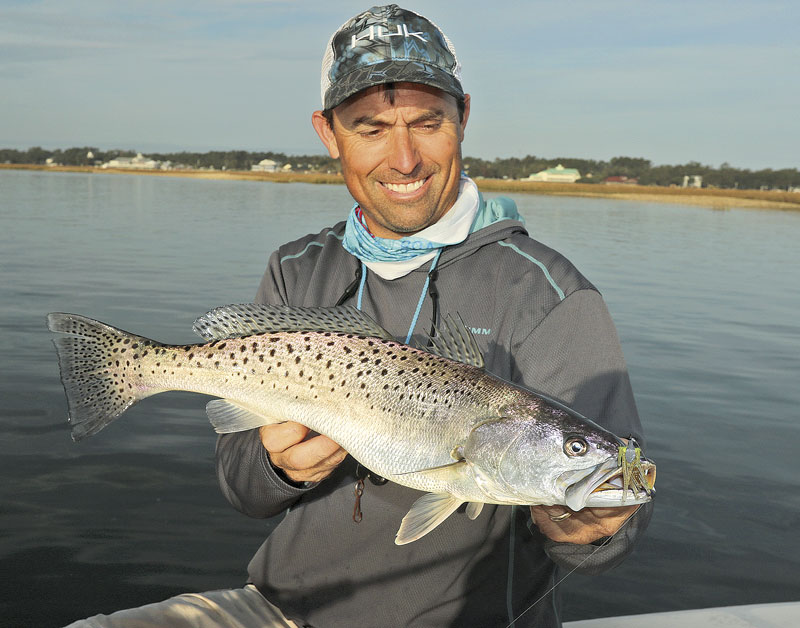 Speckled trout are an angler’s favorite wherever they swim
Speckled trout are an angler’s favorite wherever they swim
Speckled trout, Cynoscion nebulosus, are inshore gamefish that are popular among recreational anglers along the Gulf Coast and the eastern seaboard. They are hearty fighters, and most anglers agree that they are very tasty.
These fish have elongated, streamlined bodies. Their lower jaws extend beyond the upper jaws. They are usually silvery gray to green and sometimes have blue and purple highlights on their backs. Their bellies are usually white. They have flat, unforked tails with black edges. Speckled trout have two sharp teeth at the top of their mouths, which are usually yellow on the inside.
Speckled trout have long dorsal fins, which are made up of two sections. The long, rear section is soft and pliable. A deep notch separates this from the front section, which is spiny and sharp.
They are members of the Sciaenid family, which includes weakfish, sand seatrout, red drum and black drum. Like other members of that family, they have a lateral line that runs down the middle of their body all the way to the tail.
Speckled trout have prominent black spots along the upper section of their bodies, as well as on their dorsal and tail fins. On very rare occasions, a handful have been caught with no spots on their bodies. But all of those fish had spots on their dorsal and tail fins.
A huge range
The speckled trout’s range is Cape Cod to Florida and the entire Gulf of Mexico. They live along inshore waterways and from the shallows out to 30 feet deep in the Gulf. They are a schooling species for the most part, but the very large ones travel in smaller groups. Females can live up to 10 years in the wild, but males rarely reach 5 years old.
Anglers catch these fish near sea grass and shellfish banks at a variety of depths. Live shrimp and a variety of baitfish are attractive forage for speckled trout, but anglers looking for a bigger challenge love catching them on a variety of artificial lures. Topwater “walk-the-dog” lures are popular choices. Plastic shrimp under popping corks are surefire ways of finding them, and swimbaits fished on jigheads throughout the water column are very effective.
These fish, while tough fighters on hook-and-line, are known as some of the most-delicate fish among their inshore cousins. They are prone to large fish kills during periods of extreme cold weather and are less tolerant of fresh or even brackish water than most other members of the drum family.
Along the east coast, they are often misidentified as weakfish. Along the Gulf coast, they are sometimes mislabeled as sand trout or white trout. The best way to distinguish speckled trout from any of those species is by the spots on the dorsal and tail fins, which only speckled trout have.
Nicknames include spotted seatrout, specks, spotted weakfish, yellowmouth, winter trout and trout. They are infrequently known as truite gris in some Cajun circles. Bigger ones are often called gators or gator trout.
Records
Louisiana’s state-record speckled trout weighed 12.38 pounds. Leon Mattes caught the fish in Lake Hermitage in April 1950.
The world record speck tipped the scales at 17 pounds, 7 ounces and was caught in Ft. Pierce, Fla., by Craig Carson on May 11, 1995.


